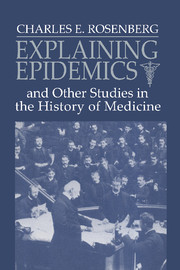Book contents
- Frontmatter
- Contents
- Acknowledgments
- Introduction: Why care about the history of medicine?
- I Ideas as actors
- II Institutions and medical care
- III The past in the present: Using medical history
- 11 The crisis in psychiatric legitimacy: Reflections on psychiatry, medicine, and public policy
- 12 Disease and social order in America: Perceptions and expectations
- 13 What is an epidemic? AIDS in historical perspective
- 14 Explaining epidemics
- 15 Framing disease: Illness, society, and history
- 16 Looking backward, thinking forward: The roots of hospital crisis
- Index
13 - What is an epidemic? AIDS in historical perspective
Published online by Cambridge University Press: 29 March 2010
- Frontmatter
- Contents
- Acknowledgments
- Introduction: Why care about the history of medicine?
- I Ideas as actors
- II Institutions and medical care
- III The past in the present: Using medical history
- 11 The crisis in psychiatric legitimacy: Reflections on psychiatry, medicine, and public policy
- 12 Disease and social order in America: Perceptions and expectations
- 13 What is an epidemic? AIDS in historical perspective
- 14 Explaining epidemics
- 15 Framing disease: Illness, society, and history
- 16 Looking backward, thinking forward: The roots of hospital crisis
- Index
Summary
Like the previous essay, this chapter was a product of the academic world's collective response to AIDS. More generally, however, I was intrigued by the challenge of trying to define and describe an epidemic. We have come to use the term so casually and metaphorically that I felt the logical way to think about the root meaning of epidemic was to see it historically, to create an ideal-typical picture of an epidemic based on repetitive patterns of past events. And in the following pages I have tried to abstract and present the narrative structure of an epidemic as historically experienced.
In some ways our generation's encounter with AIDS fits nicely into the dramaturgic pattern I suggest; in other ways recent events have evolved so rapidly that it does not. Within the space of a decade America's perception of AIDS as an acute, epidemic phenomenon has shifted subtly but inexorably: the social identity of this novel ailment has shifted into that of chronic and intractable illness, more akin to tuberculosis than cholera, leukemia than plague. In either guise, however, experience with AIDS has precisely reflected the varied realities that constitute the world's health care system as well as the social-structural and attitudinal factors that have interacted to create patterns of social response to the disease.
- Type
- Chapter
- Information
- Explaining Epidemics , pp. 278 - 292Publisher: Cambridge University PressPrint publication year: 1992
- 13
- Cited by



